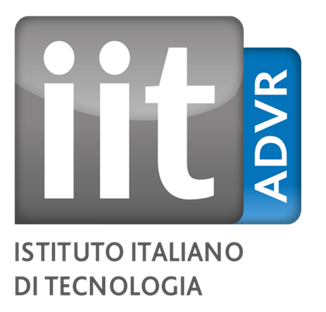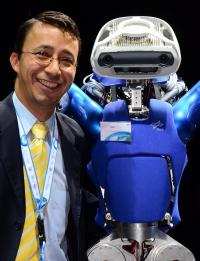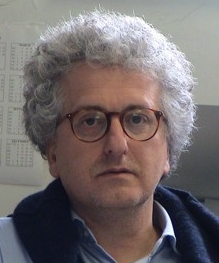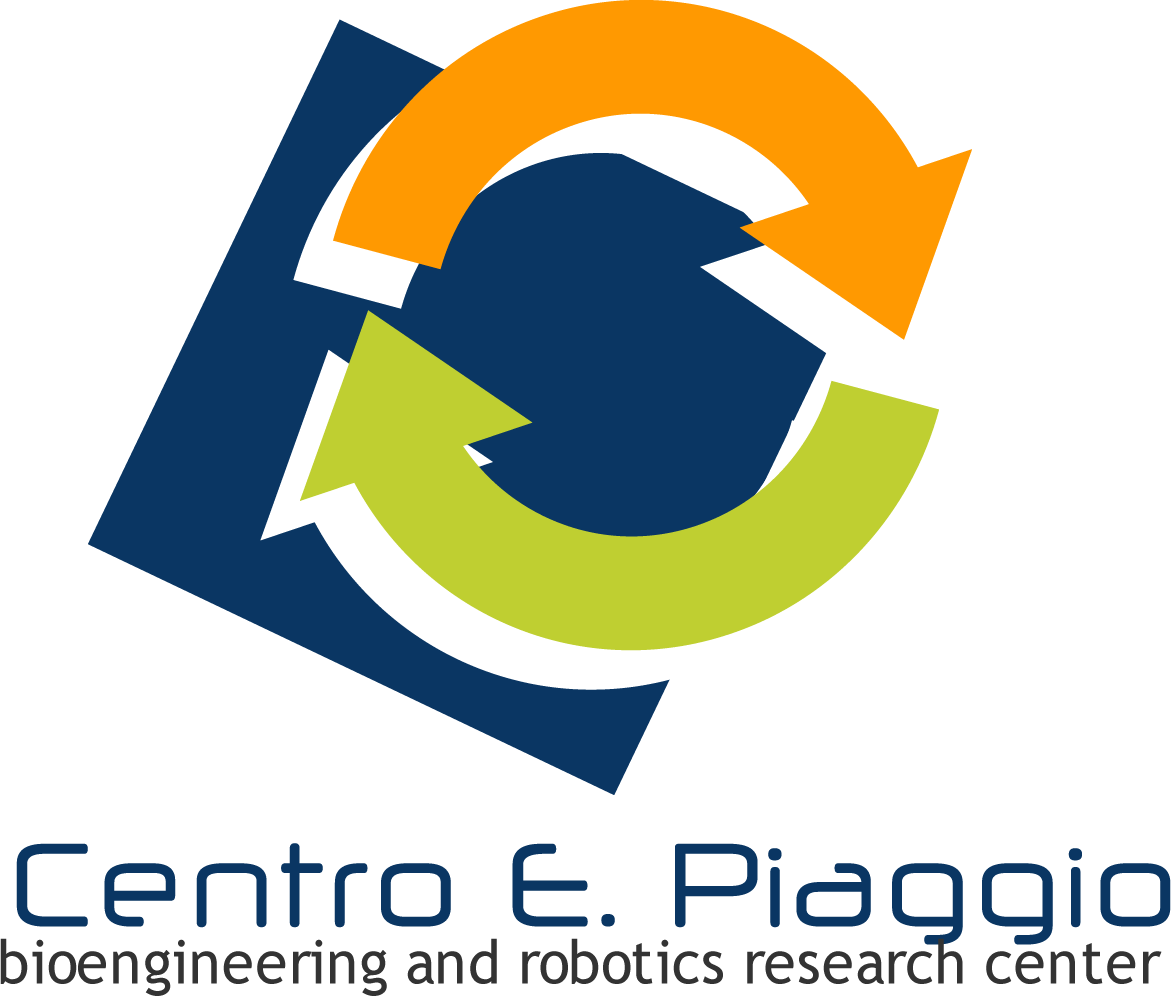|
|
|
 |

|
July 21, 2015
|
|
Paolo Rocco, Politecnico di Milano, Italy Danger field, safety field and other assessments: |
|
Abstract
New paradigms for cooperative industrial robotics do not require physical separation between robotic manipulators and humans. Safety issues arise in this scenario, while productivity has to be maximized. This talk will address methods and tools to ensure safety in such collaborative environments, focusing in particular on safety assessments and on a technique where motion of the robot is obtained as an output of an optimization-based real-time algorithm. Safety here is regarded as a hard constraint to be satisfied, compliant to safety standards. Experiments on both single-arm and dual-arm manipulators in cooperation with human operators will be shown.
|
|
|
Abstract
Motion planning -- the problem of computing physical actions to complete a specified task -- has inspired some of the most theoretically rigorous and beautiful results in robotics research. But as robots proliferate in real-world applications like household service, driverless cars, warehouse automation, minimally-invasive surgery, search-and-rescue, and unmanned aerial vehicles, we are beginning to see the classical theory fall behind. The clean assumptions of theory are at odds with the dirty reality: robots must handle large amounts of noisy sensor data, uncertainty, underspecified models, nonlinear and hysteretic dynamic effects, exotic objective functions and constraints, and real-time demands. This talk will present recent efforts to bring motion planners to bear on real robots, in the context of three projects: 1) ladder climbing in the DARPA Robotics Challenge; 2) intelligent user interfaces for human-operated robots; and 3) navigation amongst many moving obstacles. I will present new planning algorithms and architectures whose performance is backed both by theoretical guarantees and empirical evaluation.

|
|
Abstract
This talk presents a simplified model of active balancing in the plane, and a correspondingly simple control law. The model captures the physical process of balancing, and expresses it as a differential equation having only two parameters. In other words, the balancing behaviour of an arbitrary planar mechanism can be reduced to just two numbers. The controller is then a simple linear feedback law acting directly on the model. The end result is a versatile, high-performance balancer that can be applied to any planar robot mechanism that is balancing on a single point of support.
 |
Gabriel Baud-Bovy, Istituto Italiano di Tecnologia di Genova, Italy Weak force percepetion |
Abstract
Psychophysics is discipline that offers theoretical framework to develop models of perceptual and decisional processes and experimental methods to measure sensation and perception. It was created at the end of the 19th century to bring Psychology into the realm of science. In this talk, I will give illustrate this approach by presenting some examples taken on my work on haptic perception. These examples will address the capacity of our haptic system to sense small forces, how various haptic cues might be integrated during haptic exploration, and how force might be shared by a dyad in a haptic perception task.
 |
Marilena Vendittelli, Università di Roma La Sapienza, Italy Vision-based control of humanoid robots |
Abstract
This talk will discuss the role of vision in the control of humanoid robots. After briefly illustrating challenges and recent achievements in the general context, we will focus on the problem of navigation of humanoids in indoor environments made of networks of corridors connected through curves and junctions. The objective is to walk as close as possible to the corridors center, and to safely turn at curves and junctions. We will present a controller that provides asymptotic convergence of robot heading and position to the corridor bisector without making assumptions on the corridor geometry. The approach is general enough to be extended to car driving by humanoids. Experimental results for both walking and car driving will be shown.
 |
Achim Lilienthal, Centre for Applied Autonomous Sensor Systems (AASS), Sweden Why Robots Should Smell! Environmental Monitoring with Robot Systems |
Abstract
Currently, a multitude of real-world applications are becoming possible through the combination of olfaction and mobile robots. I will argue in this presentation that gas-sensitive mobile robots, and, more generally, robot systems for environmental monitoring have a huge, currently under-explored potential over a wide range of application scenarios - from carrying out routine monitoring in addition to other tasks of the robot, over dedicated surveillance missions to exploration after a disaster scenario. In order to "merge" olfaction with mobile robotics, however, it is not enough to just put gas sensors on a robot and use established algorithms. Therefore I will first highlight the specific challenges of the field and give a brief overview of traditional approaches in Mobile Robot Olfaction. Then I will present recent results and ongoing work. In conclusion, I will discuss open issues and make suggestions for future work.
 |
Darwin Caldwell, Istituto Italiano di Tecnologia di Genova, Italy Robotic Systems to Enhance Surgical Performance and Safety |
Abstract
Many (if not all) surgical procedures require significant sensorimotor (dexterity and manipulation) skills, with the surgeons having to deal with issues of scalability, access, ergonomics, localization, and hand-eye coordination etc..
Robotics has immense potential to address many of these challenges that span the medical domain, providing new assistive technologies and robotic tools to create safer, more intuitive, accurate, and efficient performance, andoverall improved quality during medical procedures.
This presentation will show how advanced surgeon-robot interfaces, sensors, actuators, vision and image processing, mechanism design, and learning systems etc. can be united with medical demands to create simulators/trainers and supervisory safety systems that can lead to innovative and exciting medical advances/procedures.
The presentation will particularly focus on the use of robotic techniques in phonomicrosurgery, with the effectiveness of these systems being shown in technology assessment trials, with resident surgeons and medical students.
 |
Máximo Roa, Robotics and Mechatronics Center, DLR, Munich, Germany |
Abstract
Passivity-based impedance controllers, based on joint torque sensing, have been traditionally applied to manipulation tasks. Experiments on grasp and reach-and-grasp will be presented in this talk, showing how the controller can cope with positional uncertainties of the object. The same framework is applied to obtain a whole-body posture controller in the robot TORO, a humanoid robot developed at DLR based on the technology of the KUKA-DLR LBR (Lightweight robot arm). This posture controller is extended for a multi-contact scenario, thus obtaining robust balancing behaviors even with uncertainty in the supporting surface.
 |
Giorgio Cannata, Università di Genova, Italy |
Abstract
The problem of „giving robots the sense of touch“ is fundamental in order to develop the next generations of robots capable of interacting with humans in different contexts: in daily housekeeping activities, as working partners, as caregivers etc.. Through tactile sensing it is possible to measure or estimate physical properties of grasped of touched objects, and feedback from tactile data may enable the detection and the safe control of the interaction of the robot with object or humans; finally touch based cognitive processes can be involved by developing self-awareness of the body and in differentiating “me” from “not me” opening new relevant problems.
The objective of this talk is to present some recent achievements in the area of tactile sensing starting from the technological aspects of robot skin design and implementation, up to the application problems where tactile data processing and feedback play a fundamental role.
 |
Nikos Tsagarakis, Istituto Italiano di Tecnologia di Genova, Italy Fast Development of a Fast Humanoid |
Abstract
The mechatronic development of humanoid systems has considerably progressed during the past three decades with various designs based on different actuation technologies, from motorized based systems to hydraulic and soft actuation technologies. Despite the advancements in the design of motorized humanoids/bipeds significant barriers remain, preventing robot hardware (physical structure and actuation) from equalling the performance of human in locomotion and full body motion agility. The talk will introduce ongoing work and results towards the development of our most recent humanoid platform WALK-MAN which was designed and developed within a very short time of 10 months. Details on the design approaches to accelerate the development process as well to achieve the necessary performance will be presented including the body design and actuation principles, the mechatronics integration and the dimensioning of the joints to reach high power and fast motion capabilities.





